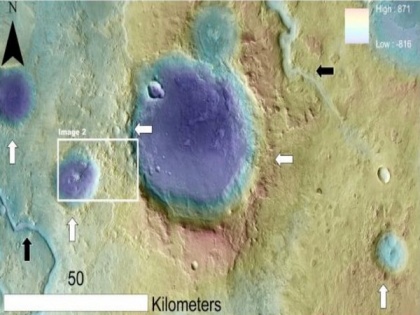Mud downpours might have formed some of Mars's ancient highlands: Study
By ANI | Published: June 25, 2020 11:04 PM2020-06-25T23:04:09+5:302020-06-25T23:20:28+5:30
Muddy rains produced by giant impacts into a primordial glaciated Mars may have played a crucial role in the emplacement of kilometers-thick mudstones on Mars, according to a new paper by a team led by Planetary Science Institute Senior Scientist Alexis Rodriguez.

Mud downpours might have formed some of Mars's ancient highlands: Study
Muddy rains produced by giant impacts into a primordial glaciated Mars may have played a crucial role in the emplacement of kilometers-thick mudstones on Mars, according to a new paper by a team led by Planetary Science Institute Senior Scientist Alexis Rodriguez.
These mudstones comprise the solar system's oldest known sedimentary rocks, according to the paper 'The Oldest Highlands of Mars May Be Massive Dust Fallout Deposits', published in Nature Scientific Reports.
Mars preserves the solar system's oldest water-modified landscapes. Rivers and glaciers are known to have extensively excavated the planet's earliest highlands, which date back to about 4 billion years ago.
"We found that impact craters and adjoining fluvially emplaced sediments in these ancient highlands were wind-excavated to enormous depths, in some cases more than a kilometer. Wind on Mars can only move sediments that are sand- or silt-sized and finer, so very fine-grained sediments must largely make up these parts of the highlands," Rodriguez said.
PSI scientists Eldar Noe Dobrea, Jeffrey S. Kargel, David A. Crown, Kevin D. Webster, and Del C. Berman are co-authors on the paper.
"When wind moves large amounts of sand, it produces dunes, but dunes are absent in these wind-sculpted terrains, suggesting that they are made mainly of silt, and perhaps clay. The wind erosion of these surfaces took place recently and might still be happening," co-author Berman said.
So, what happened about 4 billion years ago that led to the formation of these highlands? The current state of knowledge suggests that the planet's flowing water and glacial record that overprints these highlands postdates their formation by up to several hundred million years.
"However, something unique happened on Mars during this early phase in its history -- most of the planet's impact basins formed. The formation of these gigantic structures, hundreds to two thousand kilometers in diameter, would have produced extremely powerful winds and would have also most likely triggered transient climate change conducive to rainfall," Rodriguez said.
"The winds could have dislodged from the surface vast volumes of dust that existed when the impacts occurred, resulting in dust-laden atmospheric conditions. We suggest that when rainfalls happened, large amounts of the dust were removed from suspension to be redeposited as thick sedimentary units," he said.
"An interesting implication of the muddy rain hypothesis is that this process could have emplaced enormous volumes of wet sediments over the planet's extremely cold surface environments. In the likely presence ofsalts, the water-soaked mud might have produced immense aquifers with low-temperature freezing brines," he added.
So, if massive mud downpours could have formed these highlands approximately 4 billion years ago, how was that dust generated in the first place?
"On Earth, glaciers grind rocks into copious silt. Meltwater rivers wash the silt out, which then dries on river and lake beds. The dried mud commonly is picked up by the wind, which then redeposits it in mantles known as loess. So, primordial glaciation on Mars is a likely candidate to have produced the dust," co-author Kargel said.
"Another possibility is that the impacts generated the silt through the crushing of rocks and condensation of impact vapors. However, no other process on Earth today competes with glaciation as a maker of silt," Kargel added.
"NASA's Mars 2020 Perseverance rover will land nearby some of our study regions located in very similar terrains. Perseverance might sample fine-grained highlands dating from the time when life could have emerged on Earth and when heavy impact bombardment by asteroids was delivering orgcs to Mars and Earth, potentially resulting in life-forming hydrothermal systems," Rodriguez said.
( With inputs from ANI )
Open in app